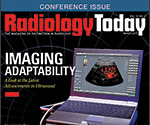 |
Ultrasound has many uses, and more are being discovered every day. For example, researchers at Johns Hopkins recently developed a way to precisely and noninvasively deliver drugs to the brain with ultrasound and nanoparticles. Read all about it in the month’s e-News Exclusive.
— Dave Yeager, editor |
 |
 |
Ultrasound Activates Release of Drugs From Nanoparticles
Biomedical engineers at Johns Hopkins report that they have developed a noninvasive way to release and deliver concentrated amounts of a drug to the brains of rats in a temporary, localized manner using ultrasound. The method first “cages” a drug inside tiny, biodegradable nanoparticles, then activates its release through precisely targeted sound waves, such as those used to painlessly and noninvasively create images of internal organs. Because most psychoactive drugs could be delivered this way, as well as many other types of drugs, the researchers say their method has the potential to advance many therapies and research studies inside and outside the brain.
They also say that their method should minimize a drug’s side effects because the drug’s release is concentrated in a small area of the body, so the total amount of administered drug can be much lower. Because the individual components of the technology—including the use of the specific biomaterials, ultrasound, and FDA-approved drugs—have already been tested in people and found to be safe, the researchers believe their method could be brought into clinical use more quickly than usual; they hope to start the regulatory approval process within the next year or two.
“If further testing of our combination method works in humans, it will not only give us a way to direct medications to specific areas of the brain, but will also let us learn a lot more about the function of each brain area,” says Jordan Green, PhD, an associate professor of biomedical engineering, who is also a member of the Kimmel Cancer Center and the Institute for Nanobiotechnology.
Details of the research were published on January 23 in the journal Nano Letters. The new research, Green says, was designed to further advance the means of getting drugs safely to the brain, a delicate and challenging organ to treat. To protect itself from infectious agents—and from swelling that can be caused by the immune system, for example—the brain is surrounded by a molecular fence, called the blood-brain barrier (BBB), which lines the surface of every blood vessel feeding the brain. Only very small drug molecules that dissolve in oil can get through the fence, along with gases. Because of this, most drugs developed for treating brain disorders fit those criteria but are dispersed to all parts of the brain—and the rest of the body, where they may be unneeded and unwanted.
Full story » |
 |
 |
Imaging in the Extremities
Cone beam CT for extremity imaging is making inroads in outpatient orthopedic centers. How will that affect radiology’s domain? Read more »
A Clearer View
Breast density is attracting increased attention among mammographers, and many states already have notification laws on the books, but characterizing and quantifying dense breast tissue remains a subjective exercise. New tools offer the potential to examine the issue more clearly. Read more »
Imaging Adaptability
What are the latest advancements in ultrasound? See what some of the major manufacturers have to say. Read more »
A Meeting of the Minds
Despite all of the angst about artificial intelligence replacing radiologists, there may come a day when radiologists need AI to do their jobs. Read more » |
 |
|
|
 |
|
|
 |
 |
New Ultrasound Technique
Images Live Cells
Researchers at the University of Nottingham have developed an ultrasound technique that can see inside living cells without damaging them. The technique, called suboptical phonon imaging, provides information about the structure, mechanical properties, and behavior of living cells.
TSA Considers Using Scanners
With 3D CT Technology
The Transportation Security Administration is considering replacing nearly decade-old scanners with new ones that utilize 3D CT technology to get a clearer view of what’s inside carry-on bags. The better view inside passengers’ carry-on is expected to help speed up heavy travel periods and reduce the number of secondary bag checks.
Less Follow-Up Imaging When Initial ED Ultrasound Interpreted by Radiologists
Researchers at the Harvey L. Neiman Health Policy Institute found that emergency department patients who receive ultrasound examinations interpreted by nonradiologists are more likely to undergo additional imaging studies after the initial ultrasound.
MRI Used to Map Malformations
in Toy Dog Breeds
Researchers in the UK conducted two studies using MRI mapping techniques to help identify dogs with Chiari malformation and Syringomyelia disorder. The researchers hope using MRI will have the potential to help veterinarians identifity dogs suffering from these painful disorders sooner. |
 |
|
